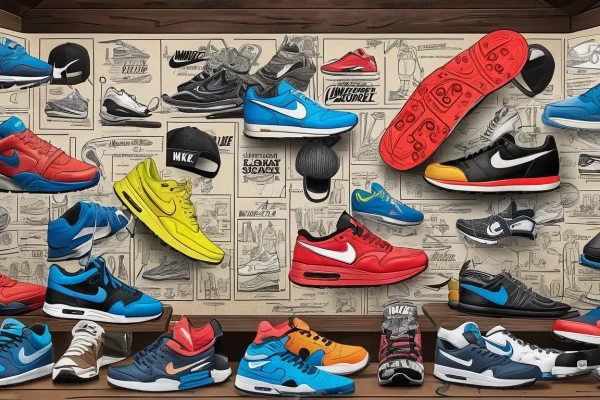Who Inspired the Story of Nike?

The story of Nike is not just about shoes; it’s about dreams, determination, and the people who dared to challenge the status quo. From its humble beginnings in a garage to becoming a global powerhouse, Nike is a testament to the vision and passion of its founders and the athletes who inspired its journey. But who are these key figures that shaped the Nike brand? Let’s dive into the rich tapestry of inspiration behind this iconic label.
At the heart of Nike’s inception are two remarkable individuals: Phil Knight and Bill Bowerman. Phil Knight, a track athlete from the University of Oregon, was driven by a desire to create better running shoes. Partnering with Bowerman, his former coach, who was always experimenting with new shoe designs, they laid the groundwork for a company that would revolutionize the sports industry. Their shared vision was simple yet powerful: to empower athletes to reach their full potential.
As Nike grew, it became increasingly clear that athletes would play a pivotal role in its marketing strategies. Superstars like Michael Jordan and Serena Williams not only embodied the brand’s ethos but also helped elevate its status in the sports world. Their endorsements brought authenticity to Nike’s products, making them the go-to choice for aspiring athletes everywhere.
One of the most significant cultural shifts came with the launch of the Air Jordan line. More than just a sneaker, Air Jordans became a symbol of style and status, driven by Michael Jordan’s unmatched influence on and off the court. This phenomenon redefined sneaker culture and created a legacy that continues to thrive today.
Nike’s marketing strategies have always been ahead of the curve. By leveraging athlete endorsements and tapping into cultural movements, Nike has crafted campaigns that resonate deeply with consumers. Take a look at some of the innovative strategies:
| Strategy | Description |
|---|---|
| Celebrity Endorsements | Partnering with top athletes to promote products. |
| Cultural Movements | Aligning with social issues to connect with consumers. |
Through collaborations with athletes and celebrities, Nike has become synonymous with aspiration for younger generations. The brand’s ability to connect with youth culture has made it a staple in not just sports but also fashion and lifestyle.
In essence, the story of Nike is woven with threads of inspiration from its founders, athletes, and the very culture they aim to inspire. Each step taken by these figures has propelled Nike into the hearts of millions, making it a beacon of achievement and ambition.
The Visionary Founders
The story of Nike begins with its visionary founders, Phil Knight and Bill Bowerman, whose passion for sports and innovation laid the cornerstone for what would become one of the most influential brands in the world. Phil Knight, a track athlete from the University of Oregon, teamed up with his coach, Bill Bowerman, to create a company that would revolutionize athletic footwear. Their journey started in the 1960s, driven by a simple yet profound idea: to help athletes perform better.
Bowerman, known for his relentless pursuit of excellence, often experimented with shoe designs to improve performance. One of his famous innovations was the creation of the waffle sole, which provided better traction and comfort for runners. This creative spirit was not just about making shoes; it was about enhancing the athletic experience. As Knight once said, “There is no finish line,” capturing the essence of their relentless drive.
Together, they founded Blue Ribbon Sports in 1964, which later became Nike, Inc. in 1971. Their partnership was a blend of vision and execution, where Knight handled the business side while Bowerman focused on product development. This synergy was critical in establishing the company’s innovative spirit.
| Founder | Background | Contribution |
|---|---|---|
| Phil Knight | Track athlete, MBA from Stanford | Business strategy and global expansion |
| Bill Bowerman | Track coach, innovator | Shoe design and technology |
Their vision extended beyond just shoes; they aimed to inspire athletes worldwide. Nike’s mission statement reflects this ambition: “To bring inspiration and innovation to every athlete in the world.” This belief in the power of sport and the potential of every individual has remained at the core of Nike’s identity.
In conclusion, the founders of Nike were not just business partners; they were pioneers who reshaped the sports industry. Their story is a testament to the impact of vision, creativity, and a relentless pursuit of excellence. As we explore Nike’s evolution, it’s essential to appreciate the foundational role played by these two remarkable individuals.
Influence of Athletes
The journey of Nike is not just about shoes and apparel; it’s about the incredible athletes who have shaped its identity. From the very beginning, Nike recognized the power of athlete endorsements as a way to connect with consumers. This strategy has been a game-changer, elevating the brand’s status and creating a cultural phenomenon.
Take, for example, the legendary Michael Jordan. His collaboration with Nike led to the creation of the iconic Air Jordan line, which not only transformed sneaker culture but also redefined how sports and fashion intersect. Jordan’s unparalleled influence turned a simple basketball shoe into a symbol of status and style, making it a must-have for both athletes and fashion enthusiasts alike.
Similarly, female athletes like Serena Williams have played a crucial role in expanding Nike’s appeal. Williams’ powerful presence on and off the court has allowed Nike to reach a broader audience, highlighting the brand’s commitment to diversity and inclusion. Her endorsements have not only boosted sales but have also sent a strong message about female empowerment in sports.
| Athlete | Impact on Nike |
|---|---|
| Michael Jordan | Revolutionized sneaker culture with Air Jordan |
| Serena Williams | Broadened brand appeal and messaging |
| LeBron James | Transcended sports with cultural influence |
Moreover, Nike has consistently tapped into the stories of these athletes, creating compelling marketing campaigns that resonate with fans. For instance, the “Just Do It” slogan, paired with powerful visuals of athletes overcoming obstacles, has become a rallying cry for those aspiring to achieve greatness. This connection between athletes and the brand fosters a sense of community, encouraging consumers to embrace a lifestyle centered around fitness and achievement.
In conclusion, the influence of athletes on Nike is profound and multifaceted. They are not just endorsers; they are integral to the brand’s narrative. As Nike continues to innovate and grow, the stories of these athletes will remain at the heart of its mission, inspiring future generations to chase their dreams.
The Air Jordan Phenomenon
The Air Jordan line is not just a collection of sneakers; it’s a cultural revolution that transcends the boundaries of sports and fashion. Launched in 1985, this iconic brand was born from the mind of basketball legend Michael Jordan, whose unmatched talent and charisma transformed the way we perceive athletic footwear. The initial release of the Air Jordan 1 was met with a mix of excitement and controversy, as the NBA banned the shoes for not adhering to the league’s uniform policy. This only fueled the fire, turning the sneakers into a symbol of rebellion and style.
What makes the Air Jordan phenomenon so special? It’s the perfect blend of sports performance and street credibility. Athletes and fashion enthusiasts alike have embraced Air Jordans, making them a staple in wardrobes across the globe. The line has expanded to include numerous models, each telling a unique story tied to Michael Jordan’s illustrious career. The legacy of Air Jordans can be seen in the following key elements:
| Model | Release Year | Significance |
|---|---|---|
| Air Jordan 1 | 1985 | First model, banned by the NBA |
| Air Jordan 3 | 1988 | Introduced the Jumpman logo |
| Air Jordan 11 | 1995 | Worn during MJ’s first championship return |
Moreover, the marketing strategies surrounding the Air Jordan brand have been nothing short of genius. Nike has utilized a combination of celebrity endorsements and grassroots movements to create a buzz around each release. The brand’s slogan “It’s gotta be the shoes!” became a cultural catchphrase, further embedding Air Jordans into the fabric of society.
In essence, the Air Jordan phenomenon is a testament to the power of branding and the influence of a single athlete. It has shaped sneaker culture, created a multi-billion dollar industry, and inspired countless individuals to chase their dreams, both on and off the court. As we look to the future, one can only wonder how the legacy of Air Jordans will continue to evolve and inspire new generations.
Marketing Strategies
Nike’s marketing strategies have been nothing short of revolutionary, propelling the brand to the forefront of the athletic industry. By leveraging the power of athlete endorsements and cultural movements, Nike has created a unique connection with consumers that goes beyond mere products. Imagine walking down the street and seeing a pair of Air Jordans; it’s not just footwear, it’s a statement, a lifestyle. Nike has mastered the art of storytelling, crafting narratives that resonate deeply with their audience.
One of the key elements of Nike’s marketing approach is its ability to tap into the emotions of its consumers. Through powerful advertisements, Nike inspires individuals to push their limits, making them feel like they can achieve anything. This is evident in their iconic slogan, “Just Do It,” which serves as a rallying cry for athletes and dreamers alike. But how does Nike maintain this level of engagement? Let’s break it down:
| Strategy | Description |
|---|---|
| Celebrity Endorsements | Nike collaborates with top athletes like Michael Jordan and Serena Williams to enhance brand visibility. |
| Innovative Campaigns | Unique marketing campaigns that often go viral, such as the “Dream Crazy” campaign featuring Colin Kaepernick. |
| Community Engagement | Building local communities through events, sponsorships, and social initiatives. |
These strategies not only amplify Nike’s presence in the market but also deepen the emotional connection with consumers. For instance, Nike’s collaboration with athletes transcends the sports world, making the brand a cultural icon. When you see Serena Williams on a billboard, it’s not just about tennis; it’s about empowerment and breaking barriers.
Moreover, Nike’s marketing strategies have had a profound impact on youth culture. The brand has become synonymous with aspiration, encouraging young people to pursue their dreams. By aligning itself with cultural movements and social justice issues, Nike positions itself as a leader in not just sports, but in societal change. This is not just marketing; it’s a movement.
So, what can we learn from Nike’s marketing strategies? It’s all about authenticity, connection, and a relentless drive to inspire. As Nike continues to evolve, one thing remains clear: their ability to resonate with consumers will keep them at the pinnacle of the athletic industry.
Impact on Youth Culture
Nike has not just been a brand; it has become a cultural phenomenon that resonates deeply with the youth. The brand’s ability to connect with younger generations stems from its strategic collaborations with influential athletes and celebrities. These partnerships have transformed Nike into a symbol of aspiration, achievement, and identity. When a young person wears Nike, they are not just wearing shoes; they are embracing a lifestyle, a dream, and a sense of belonging.
Consider the way Nike markets its products through powerful storytelling. By showcasing athletes who have overcome adversity, Nike inspires youth to chase their dreams relentlessly. This emotional connection is further amplified by social media, where young fans engage with the brand and share their own stories. Nike has mastered the art of creating a community around its products, making it a staple in youth culture.
One of the most significant aspects of Nike’s impact on youth culture is its ability to adapt to changing trends. The brand has embraced streetwear, collaborating with artists and fashion designers to create limited-edition releases that appeal to a broader audience. This strategy not only keeps Nike relevant but also allows it to tap into the urban culture that many young people identify with.
| Collaboration | Impact on Youth Culture |
|---|---|
| Travis Scott | Infused hip-hop culture into sneaker design, appealing to music fans. |
| Virgil Abloh | Bridged the gap between high fashion and sportswear, attracting fashion-forward youth. |
Furthermore, Nike’s initiatives, such as the Nike Community Impact Fund, emphasize its commitment to empowering youth through sports. By funding programs that provide access to sports facilities and coaching, Nike is not just selling products; it’s investing in the future of young athletes. In doing so, they are fostering a generation that values health, teamwork, and perseverance.
In conclusion, Nike’s influence on youth culture is profound and multifaceted. The brand’s ability to innovate, inspire, and connect with the younger audience has solidified its status as a cultural icon. As Nike continues to evolve, its legacy of empowerment and aspiration will undoubtedly carry on, shaping the dreams and identities of future generations.
Women in Sports
When we think of , it’s impossible not to recognize their monumental impact on brands like Nike. These incredible athletes have not only shattered records but have also redefined what it means to be a female sports icon. Take Serena Williams, for example; her prowess on the tennis court has made her a household name and a pivotal figure in Nike’s marketing strategy. By endorsing Nike, she has helped elevate the brand’s appeal among women, making it synonymous with strength, resilience, and empowerment.
Nike’s commitment to promoting female athletes is evident in their campaigns that not only showcase athleticism but also celebrate femininity and individuality. This approach has allowed Nike to resonate with a broader audience, inspiring young girls everywhere to chase their dreams, just like their athletic idols. The message is clear: Women belong in sports, and Nike is here to support them.
Here’s a quick look at some of the remarkable women who have influenced Nike’s brand identity:
| Athlete | Sport | Contribution |
|---|---|---|
| Serena Williams | Tennis | Redefined athleticism and femininity in sports. |
| Allyson Felix | Track and Field | Advocated for maternity rights for female athletes. |
| Lisa Leslie | Basketball | Pioneered women’s basketball and inspired future generations. |
The influence of women in sports extends beyond just the athletes themselves. Nike has also made a concerted effort to focus on female empowerment through various initiatives, including:
- Women’s Training Programs: Creating spaces for women to train and compete.
- Collaborations with Female Designers: Infusing fresh perspectives into sportswear.
- Community Engagement: Supporting local initiatives that encourage young girls to participate in sports.
In conclusion, the role of women in sports is not just a chapter in the story of Nike; it’s a vital part of the brand’s DNA. By championing female athletes and their stories, Nike has created a legacy that inspires and empowers women everywhere to pursue their passions fearlessly.
Cultural Icons and Collaborations
Nike has always been more than just a sportswear brand; it’s a cultural phenomenon. The collaborations with various cultural icons have played a pivotal role in shaping its identity and expanding its reach beyond the athletic sphere. By partnering with artists, designers, and influencers, Nike has infused its products with a unique blend of creativity and urban flair. This strategy has not only kept the brand relevant but has also made it a staple in both the sports and fashion industries.
One of the most notable collaborations was with the renowned artist Virgil Abloh, whose Off-White label brought a fresh perspective to Nike’s classic silhouettes. This partnership was a game-changer, as it merged high fashion with street culture, appealing to a diverse audience. The result? A line of sneakers that became instant collector’s items, showcasing how Nike can adapt and thrive in a constantly evolving market.
Another significant collaboration is with Travis Scott, a cultural icon in the music industry. His unique style and approach to fashion resonated with Nike’s ethos, leading to the creation of limited-edition sneakers that sold out within minutes. This partnership not only highlighted the power of celebrity influence but also demonstrated how Nike can tap into the cultural zeitgeist to create buzz and excitement.
| Collaborator | Impact on Nike |
|---|---|
| Virgil Abloh | Blended high fashion with streetwear, creating collector’s items. |
| Travis Scott | Generated massive hype and sales with limited-edition releases. |
This approach to collaborations has not only enriched Nike’s product offerings but has also fostered a sense of community among consumers. By aligning with figures who embody innovation and creativity, Nike has positioned itself as a brand that champions self-expression and individuality. In an age where authenticity is paramount, these partnerships resonate deeply with younger generations, making Nike synonymous with aspiration.
In conclusion, Nike’s strategic collaborations with cultural icons have been instrumental in shaping its brand image. As the company continues to innovate and engage with diverse voices, it remains at the forefront of both the sports and fashion worlds, inspiring countless individuals to express themselves through the power of sport.
Streetwear Influence
Nike has seamlessly blended the worlds of streetwear and sportswear, creating a cultural phenomenon that resonates with consumers of all ages. This fusion isn’t just a trend; it’s a movement that has redefined how we perceive athletic gear. Think about it: when you see someone rocking a pair of Nike Air Force 1s on the street, they’re not just wearing shoes; they’re making a statement. This intersection of fashion and functionality has allowed Nike to tap into the pulse of urban culture, making their products not just athletic wear but also a staple in everyday style.
One of the key factors in this evolution has been the collaboration with influential figures in the streetwear scene. For instance, partnerships with designers like Virgil Abloh and artists like Travis Scott have brought a fresh perspective to Nike’s offerings. These collaborations have not only introduced innovative designs but have also created a buzz that transcends the traditional athletic market. The result? A new generation of consumers who view Nike as a symbol of both performance and style.
| Collaboration | Impact |
|---|---|
| Virgil Abloh | Reimagined classic silhouettes with a high-fashion twist |
| Travis Scott | Infused hip-hop culture into sneaker design, appealing to younger audiences |
Moreover, Nike’s ability to adapt to trends has been key to its success in the streetwear realm. The brand has embraced the DIY ethos prevalent in street culture, encouraging customers to customize their gear. This not only fosters a sense of ownership but also allows individuals to express their unique style through Nike products. It’s like turning a blank canvas into a personal masterpiece!
In conclusion, Nike’s influence in the streetwear landscape is undeniable. By merging athletic performance with urban aesthetics, they have created a brand that speaks to the aspirations of a diverse audience. As we continue to see this evolution, one can only wonder: what will the next chapter in Nike’s streetwear story look like?
Global Impact
Nike’s journey is nothing short of a global phenomenon, transcending borders and cultures to inspire millions. The brand has become synonymous with athleticism, style, and innovation, impacting not just sports but also the way people express themselves worldwide. From the bustling streets of Tokyo to the vibrant neighborhoods of New York City, Nike’s influence is felt everywhere.
One of the key elements of Nike’s global impact is its ability to connect with diverse audiences. The brand has tailored its marketing strategies to resonate with local cultures while maintaining its core identity. This adaptability is evident in the various campaigns Nike has launched across different regions, showcasing local athletes and cultural icons. For instance, the “Just Do It” campaign has been localized in many languages, yet it carries the same empowering message that inspires individuals to push their limits.
| Region | Key Campaigns | Local Icons |
|---|---|---|
| North America | Just Do It | Michael Jordan, Serena Williams |
| Asia | Play New | Yao Ming, Liu Xiang |
| Europe | Nothing Beats a Londoner | Mo Farah, Raheem Sterling |
Nike’s collaborations with international athletes have also played a crucial role in its global reach. These partnerships not only elevate the brand but also create a sense of community among fans. For example, when Nike teamed up with soccer superstar Cristiano Ronaldo, it tapped into the massive football fanbase across Europe and Latin America, further solidifying its status as a global leader.
Moreover, Nike has embraced social movements, aligning itself with causes that resonate with younger generations. This approach has not only enhanced its brand image but has also fostered a sense of social responsibility among consumers. By supporting initiatives like equality in sports and environmental sustainability, Nike has positioned itself as a brand that cares, which is vital in today’s socially conscious market.
In conclusion, Nike’s global impact is a testament to its ability to adapt, innovate, and inspire. The brand’s journey is not just about selling products; it’s about creating a movement that encourages individuals to pursue their passions, regardless of where they are in the world.
Frequently Asked Questions
- Who are the founders of Nike?
Nike was founded by Phil Knight and Bill Bowerman. Their combined vision for innovative athletic footwear and dedication to quality set the stage for what would become a global powerhouse in sportswear.
- How have athletes influenced Nike’s success?
Athletes like Michael Jordan and Serena Williams have played a crucial role in shaping Nike’s marketing strategies. Their endorsements not only elevated the brand’s status but also inspired product designs that resonate with sports enthusiasts around the world.
- What is the significance of the Air Jordan line?
The Air Jordan line revolutionized sneaker culture, merging sports with fashion. It created a lasting impact, making sneakers a staple in everyday wear and establishing Michael Jordan as a cultural icon.
- How does Nike connect with youth culture?
Nike’s collaborations with athletes and celebrities have made it synonymous with aspiration among younger generations. By aligning with cultural movements, Nike has become a symbol of achievement and self-expression.
- What is Nike’s approach to marketing?
Nike employs innovative marketing strategies that leverage athlete endorsements and cultural relevance. This approach helps them connect deeply with consumers, making their campaigns memorable and impactful.
- How has Nike expanded its influence beyond sports?
Through partnerships with artists and designers like Travis Scott and Virgil Abloh, Nike has infused fresh creativity into its brand. This expansion into mainstream culture has broadened its appeal and relevance across diverse audiences.
- What role do women athletes play in Nike’s branding?
Female athletes, such as Serena Williams, have significantly shaped Nike’s brand identity. Their endorsements have not only broadened Nike’s appeal but also highlighted the importance of women in sports.





